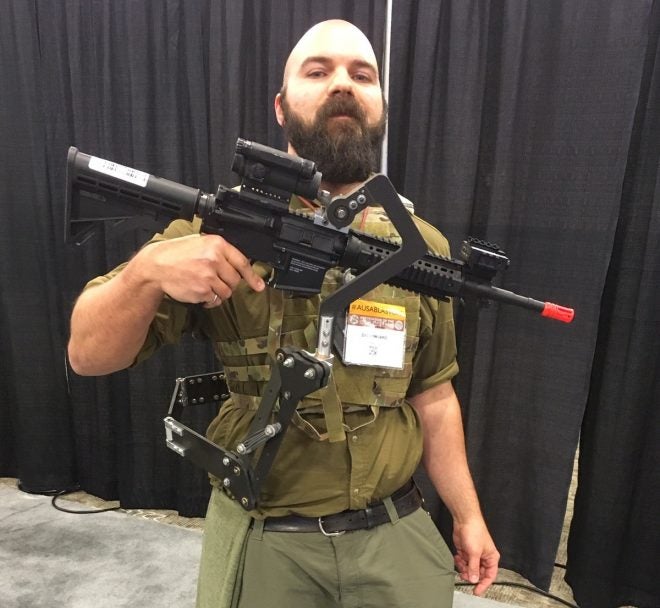El “Tercer Brazo” desarrollado por el Army Research Laboratory (ARL), está diseñado para redistribuír eficientemente el peso de las armas que los soldados llevan en sus brazos y hombros, hacia el torax y abdomen. Ello hace más fácil el transporte del armamento por períodos prolongados, beneficiando la salud a largo plazo de los combatientes Pero fundamentalmente, permite que las armas continúen en aptitud de rápido empleo, mientras alguno de los brazos realiza otra función.
The US Army’s ‘Third Arm’ is designed to redistribute some of the weight soldiers carry in their arms and shoulders to their abdomen. This could make carrying heavy equipment and weapons over long distances much easier, lowering the short and long-term impact on troops’ health. Launched in 2015, the mechanical arm is about to enter its next phase of testing.
Reminiscent of the M56A2 Smart Guns toted by Colonial Marines in the movie Aliens, the Third Arm was designed to help stabilise a soldier’s rifle and also spread the weapon’s weight. While The development prototype is frequently photographed holding an airsoft M4, the applications for hefting around an M240 over long distances are clear.
One of the mechanical engineers working on the project, Dan Baechle, told the Army News Service, that “right now we have a prototype that’s essentially a research platform that we’re using to investigate different types of materials” he explained that “materials and structures can stabilize a weapon or a shield, reduce fatigue on the Soldiers’ arms, but also improve accuracy.”

Engineers at the Army Research Lab (ARL) unveiled the Arm at the 2017 AUSA conference. The 3.5 lb mechanical apparatus has already undergone some troop testing last summer. Development of the armbegan in 2015, with the second prototype model now being tested.
Baechle explained the original ideas behind the Third Arm:
We started out with just trying to think of a way to help improve the lethality for the dismounted Soldier… Generally that means stabilizing the weapon or giving the Soldier a more powerful weapon. Can we stabilize that weapon to improve accuracy? But also if we’re stabilizing the weapon and taking the load off of the Soldiers’ arms, does that improve the Soldier’s readiness? Does it also improve the Soldier’s accuracy with the weapon?
Initial test feedback from troops saw the arm’s mounting point shifted from the front to the lower back. ARL hopes to continue improving the Arm to maximise comfort for the user, minimise fatigue and help improve soldiers’ aim. The Army plans to run another round of testing in the Spring, this time with 15 soldiers. ARL researchers hope that with further development the Arm might be able to help reduce felt recoil too.
Of course systems like the Third Arm raise questions about mobility, reliability in the field and potential loss of flexibility for soldier’s using them. But the ARL’s Third Arm is just one of a number of programs aimed at lightening the soldier’s burden, through mechanical engineering, currently underway around the world.
Another, much simpler system is the Reaper Weapon Carriage System, developed by Advanced Accuracy Solutions, tested by the Australian Army. The cradle-based system is designed to do much the same task as the Third Arm but instead utilises an overhead cradle and sling.
‘Third Arm’ and the Reaper represent just a couple of the number of technology-based attempts to address the issue of increasing equipment load weights currently being investigated. Other load-bearing and weight distribution systems are in development in the US and elsewhere, including everything from cradles for heavy weapons to powered exoskeletons.
Fuente: http://www.thefirearmblog.com

